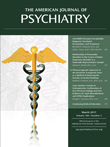Mark F. Lenzenweger provides a well-written and extensive overview of schizotypy and its relation to schizophrenia. The author notes that the book is targeted toward advanced undergraduate and graduate students in psychological sciences. However, I found it to be an excellent compilation of the research in schizotypy and the nature of its continuum with schizophrenia. The book is sprinkled with clinical examples of the concepts that caused me to reflect on patients who I have treated in the past. For example, in one case the author raises the role of social anxiety in the schizotypy phenotype. I remember several patients who were referred from an anxiety disorders program to my youth psychosis program because they did not seem to fit the anxiety disorder mold. They did not have psychosis but rather a pronounced anxiety with social encounters coupled with oddities in behavior. Such patients fall into the schizotypy phenotype. Indeed, Lenzenweger makes the comment that “nearly all of the research vectors that I have pursued in the laboratory have begun as clinical observations” (p. 24). Thus, while heavily weighted toward research design and analysis, the book also encompasses clinical relevance. It is a book that is not only for students of psychological sciences but can also serve as interesting reading for psychiatric residents and interested clinicians who desire a thorough review on the topic, including research design, methods, and interpretation.
Following the introduction, the book is divided into three different sections. The introduction is worthy of discussion, as Lenzenweger raises a scientific tenet that I held in my mind throughout the book. He argues that the best approach to the study of schizophrenia is to fully incorporate individuals with schizotypy into schizophrenia research—to include them in the model. He goes on to argue that these individuals “have a valid alternate expression of the schizophrenia liability…and thus are the real thing,” and “they have less confounds resulting from medication use and institutionalization” (p. 17). In a world of lumpers and splitters and those in between, I was curious. I read on.
The first section provides important definitions and primary statistical discussion for studies in psychopathology. Fortunately, this was not merely an encyclopedia list of definitions and terms, but rather Lenzenweger describes the historical emergence of these terms within the field and discusses real-life applications and applications gone awry. It provides a well-written and excellent overview of basic terms used for measuring psychopathology. In this first section, Lenzenweger argues that “heterogeneity is our friend” (p. 89).
Perhaps, I thought. But it would seem to me that if schizophrenia involved a single gene mutation with exactly the same phenotype, it would certainly make it much easier. But such is not the case, and in such a complex and heterogeneous disorder such as schizophrenia, perhaps heterogeneity can be our friend. I read on.
The second section delves into the neurobiology and experimental psychopathology of schizotypy. Here, the author describes the schizotypy phenotype, epidemiology, endophenotypes, epigenetics, and the genetics of schizotypy. He also discusses neuropsychological data and makes the important point that some of the simplest tasks can provide very valuable information. While there are considerable data on schizotypy and schizophrenia presented, the author appears to be more focused on providing a framework for critically assessing and understanding the literature. He discusses early models introduced by researchers, such as Paul Meehl and Irving Gottesman, and how these models contribute to our current understanding of schizotypy. He also raises the importance of thinking outside of the DSM box.
While the third section involves the author's thoughts and reflections gleaned through his extensive research in the study of schizotypy, these thoughts and reflections are actually present throughout the book. One interesting discussion is raised over individuals who are at high risk for developing psychosis. Lenzenweger argues that these individuals who are at high risk are actually genuine “schizotypes” (p. 303), and the actual question is which of these individuals will progress on to the full schizophrenia phenotype. However, if Lenzenweger describes “schizotypes” as “the real thing,” then this has potential ramifications for research into ultra-high risk populations.
In summary, the book provides an interesting and well-written overview of schizotypy. It is heavily weighted toward research methods and design and a scientifically based approach to the literature. The book also contains excellent clinical vignettes that provide clinical relevance to the concepts. Finally, I think Lenzenweger makes an excellent argument that heterogeneity can be our friend. We need not rush out looking for a schizotypy prodrome, for they will be found among those with the schizophrenia prodrome.

